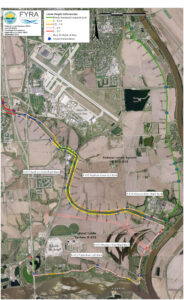The U.S. Army Corps of Engineers and Nebraska’s Papio-Missouri River Natural Resources District (P-MRNRD) share a common goal of preventing loss of life and property through effective floodplain management. However, while trying to achieve this critical goal, both organizations found themselves struggling to effectively work through a permission process required to perform federally mandated enhancements to existing levees on the Missouri River to ensure public safety during a flooding event.
In 2006, the Federal Emergency Management Agency (FEMA), operating under the Flood Map Modernization Presidential Initiative, began to remap the Missouri River floodplains and update the base flood elevations to ensure sufficient freeboard for 100-year flood protection. During the process, two sets of levees operated by the P-MRNRD near Omaha, Nebraska, were identified as needing upgrades to meet FEMA certification.

The levee systems, which lie south of Omaha near the confluence of the Missouri and Platte Rivers, protect a sewage treatment plant, multiple rail lines, and Offutt Air Force Base—home to the 55th Wing and the U.S. Strategic Command. According to P-MRNRD General Manager John Winkler, those facilities combine to contribute $1.3 billion in annual economic benefit to Nebraska.
Protection of the Air Force base and local industry made obtaining FEMA recertification a top priority not only for P-MRNRD, but also for Sarpy County, surrounding municipalities, and the state of Nebraska. Adding even more weight to the situation, the military was considering Offutt as part of base realignment and potentially moving the 55th Wing.
Although the identified levee systems were not in disrepair, even outperforming other levees in a 500-year flood event in 2011, P-MRNRD acted to address the enhancements urgently to ensure reliable protection. In 2011, the district began developing a thorough project plan and discussed the initiative with the Army Corps, which was to certify and permit the project work. Although P-MRNRD knew there would be extensive permitting, the Army Corps was not clear whether a new section 408 permit would apply to this project.
John Winkler described how the permitting process unfolded. “When we started the permitting process, it appeared the project might not need a 408 permit; but from the outside, it appeared the Army Corps was struggling to determine what projects the 408 permit should apply to. A few years into the project development process, there was a whole new directive on 408 handed down from [Army Corps] headquarters. It was at that point the Corps determined we needed a 408. We had already moved on. By no means had we started construction, but we were deep into project planning and design and thought we did not need one. However, we had to begin this new permitting process.”
In the early part of the decade, many local Army Corps partners, such as P-MRNRD, did not know what the parameters of section 408 permission entailed. Section 14 of the River and Harbors Appropriation Act of 1899 (33 U.S.C. 408) provides that the “Secretary of the Army may, on recommendation of the Chief of Engineers, grant permission for the alteration of a public work so long asthat alteration is not injurious to the public interest and will not impair the usefulness of the work.” The legislative directive seems simple enough, but has proved to be complicated, lengthy, and costly for local partners seeking to undertake flood control improvements on Army Corps projects.
In 2015—a full 4 years after the start of the project— P-MRNRD had entered into a memorandum of understanding (MOU) to secure around $25 million in funding from municipal, county, and state governments. Yet, the district did not have permission to begin the levee enhancement. With the project plan submitted and funding secured, the project was essentially on hold while P-MRNRD worked with the Army Corps to answer questions, provide information—sometimes information that had already been provided to Army Corps personnel, who subsequently changed jobs—and worked through many internal procedural changes the Army Corps instituted during the process.
After the MOU, the permission process began to fall more squarely in the public eye. With so much of the local economy at stake, both the public and P-MRNRD’s local partners inquired about the progress of the permission process. It even caught the attention of Nebraska’s congressional delegation, drawing questions from Congressman Jeff Fortenberry and Senator Deb Fischer at hearings in both the House and the Senate. The attention helped move the process forward.
As of May 2018, P-MRNRD expects to receive a section 408 permission approval within a couple of weeks. At that point, according to Mr. Winkler, the district will put out a formal request for proposal to begin construction on the two levee systems by the end of 2018.
Since P-MRNRD’s initial inquiry into levee repairs, the Army Corps has instituted guidance to help expedite the 408 process. According to its draft guidance, which is currently out for public comment, the Army Corps seeks to eliminate duplication, allow district offices to be more involved during the decisionmaking process, clarify the processes for their personnel as well as applicants, and create a publicly accessible database to view the progress of 408 requests through every step of the certification process.
P-MRNRD recognizes this effort as well. Mr. Winkler noted, “The [Army Corps] is trying to make the process better and more streamlined.”
Even with the improvements, his advice to other flood management districts or water agencies is to open up lines of communication. “It would behoove anyone undertaking a project on Army Corps projects to dive into communications right away. It will save time and energy. Communications among all stakeholders in your organization and the Army Corps will ensure nothing is missed, guidance is handed down, and the process keeps moving forward.”
